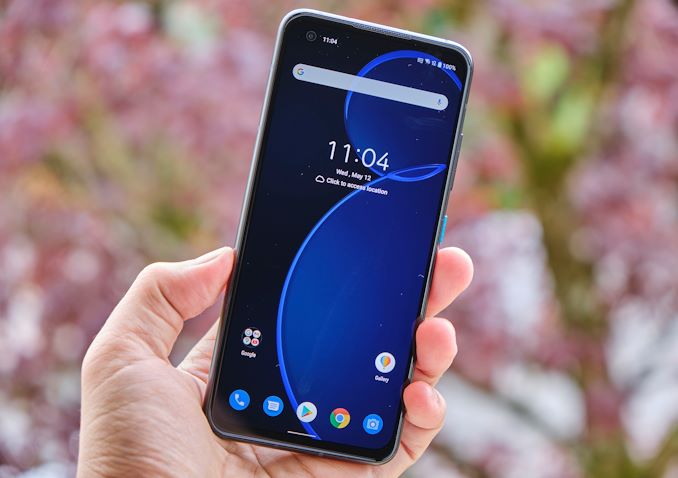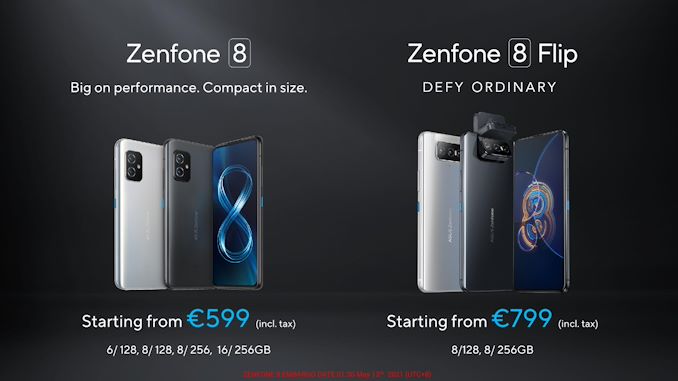The ASUS Zenfone 8 Hands-On Review: A New Compact Direction
by Andrei Frumusanu on May 12, 2021 1:30 PM EST- Posted in
- Smartphones
- Asus
- Mobile
- Zenfone 8
Conclusion & First Impressions
Today’s launch of the Zenfone 8 series is an interesting attempt by ASUS to position themselves in a gap in the market. The focus is clearly on the new Zenfone 8 which introduces as new smaller form-factor, and in many ways, it’s a unique device in the market because of that.
ASUS’s efforts in creating a smaller flagship phone work out well in terms of the actual form-factor and ergonomics of the Zenfone 8. The phone it actually reminded me the most of is the Pixel 5, both petite devices of similar dimensions, with the Zenfone 8 of course being built of more premium materials and having higher grade hardware components.
The display at 5.9” lands at a sweet-spot in terms of density for the 2400 x 1080 resolution. While we didn’t cover the matter in a dedicated section, I was actually impressed by the quality of the image calibration of the phone, allowing for near perfectly balanced white colour temperature in the settings, something many vendors struggle with. The 120Hz refresh rate of the panel is also great for general responsiveness of the device – however it comes at a cost of battery life.
While the phone has a 4000mAh battery, generally you can only expect good results in the 60Hz mode as like with many other devices this year, the Zenfone 8 features odd power consumption regressions. The 60Hz mode in turn comes at a cost of a regression of user experience that isn’t nearly as fluid as the 120Hz mode.
Performance of the phone is adequate, however aspects such as the sustained GPU and gaming performance of the phone, while adequate, isn’t the best due to the heavier throttling of such a smaller device.
Finally, there’s the cameras, and much like on the Zenfone 7 last year, it can be a deal-breaker for potential buyers. The camera hardware as well as the image processing just aren’t up to par with the competition. While the cameras are functional, they are well behind any competitor solution.
As we always say, there’s no bad product, just bad prices. In that regard, ASUS prices the Zenfone 8 at a very competitive 599€ starting price, which is far below the positioning of similarly specced competitors. The thing is though, is that while ASUS positions itself as a cheaper alternative, it also comes with quite a lot of drawbacks and compromises. Amongst the “small-phone” crowd, there’s really only the Xperia 5 III which isn’t available yet and comes at an eye-water 922€, or simply the Galaxy S21 which can be had today at 680€ - more expensive than the Zenfone 8, but also a vastly better device.
The Zenfone 8 Flip is quoted to start at 799€. Due to the meagre improvements of the Snapdragon 888 this year I would rather just advise to consider the Zenfone 7 at only 432€ right now if you’re after the flip-camera design, given that all other features and specifications between these two phones are the same.
Finally, there’s the continued issue of availability and limited releases depending on country and markets. I had asked ASUS about their recent track-record of having extremely slow roll-outs, with users sometimes waiting months to be able to purchase the phones in their specific region or country. Similarly, the Zenfone 8 series don’t have any concrete sell date or more specific pricing beyond the European start prices showcased in the above slide. ASUS had replied that they’re aiming to do better this year, but again shying away from disclosing any more concrete per-country availability information.
In that context, given the lack of availability dates as well as obvious better value competitor devices, it’s hard to recommend the new Zenfone 8 series phones – the company still has a lot of work ahead of it if it wants to be a contender in the mobile market.












66 Comments
View All Comments
Tams80 - Tuesday, May 18, 2021 - link
The XZ2 isn't really compact.Tams80 - Tuesday, May 18, 2021 - link
And?You do realise there are people happy to make that trade-off, even if they are only a small group? And the XZ1 has pretty decent battery life.
The market is absolutely saturated with large phones, which are popular. That doesn't mean only large phones should exist.
People like you really grate my gears.
Findecanor - Thursday, May 13, 2021 - link
Agreed. Smartphones do keep getting bigger, but people's hands do not.It is also not "the smallest flagship by far". It is about the same size as the iPhone 12/Pro, and weight-wise in-between. And if we compare to flagships from last spring, we got the Samsung Galaxy S20.
haukionkannel - Thursday, May 13, 2021 - link
True… only iPhone 12 mini seems to be allmost compact and no Android versions have been around for years…Linustechtips12#6900xt - Thursday, May 13, 2021 - link
12 mini or se 2020Linustechtips12#6900xt - Thursday, May 13, 2021 - link
as an s10e user, the s10e without a case does very well fit in a single hand thank you very much especially when used with the one-handed feature or just on one ui, in general, that's what one UI was made for to be better on bigger phone and make them easier to use even though s10e is compact it is a very decent phone.inperfectdarkness - Sunday, May 16, 2021 - link
XZ2 Compact > XZ1 Compact, imho. Damn shame Sony doesn't care diddly squat to make another 5" phone. Everything is 6" now.prophet001 - Thursday, May 13, 2021 - link
Anybody know a good 4g phone that's like the size of a Blackberry Bold. I like having it in my pocket and can't find anything that is that size and still has email, web etc.Thanks!
hemedans - Thursday, May 13, 2021 - link
sony xperia xz1 compact-height
bold 115cm
xz1c 128cm
-width
bold 66cm
xz1c 65cm
-depth
bold 10.5cm
xz1c 9.3 cm
xz1c will be narrow and compact but a little bit taller.
inperfectdarkness - Sunday, May 16, 2021 - link
Bold: 115 x 66 x 10.5 mm (4.53 x 2.60 x 0.41 in)XZ1 Compact: 129 x 65 x 9.3 mm (5.08 x 2.56 x 0.37 in)
XZ2 Compact: 135 x 65 x 12.1 mm (5.31 x 2.56 x 0.48 in)
Those are the closest you'll find outside of something pitifully small and unusable--which is pretty much every phone in the < 4" size.
The XZ2 Compact - international version - can handle dual SIM cards or SIM + SD.